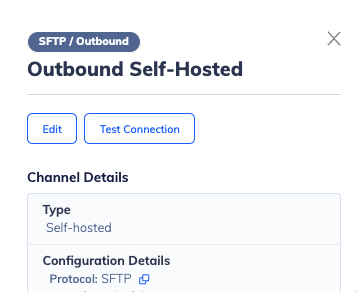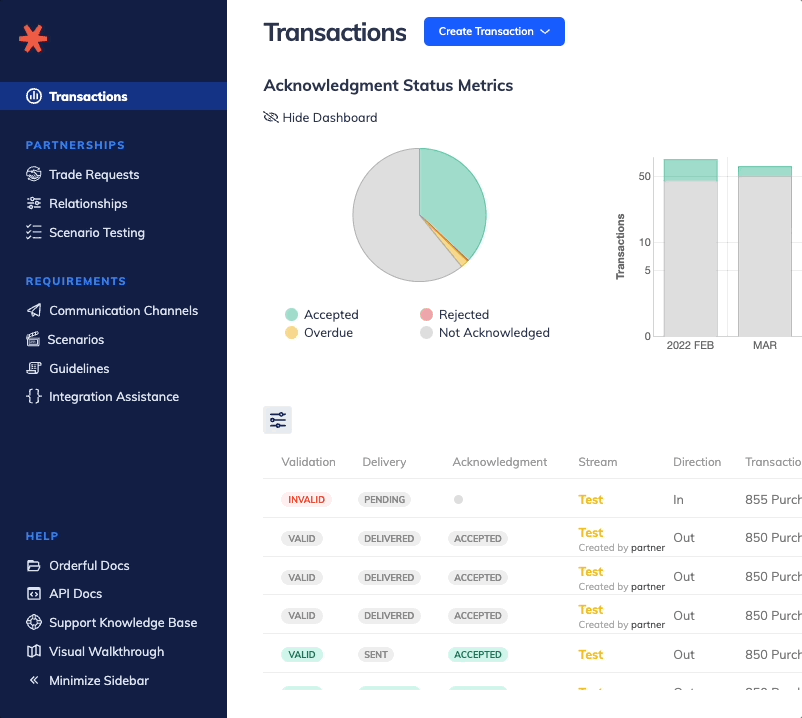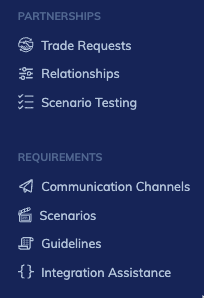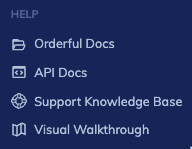We have removed the "Direction" of Guidelines. Guidelines can now be assigned to both outbound and inbound Relationships. This means that Organizations that both send and receive transactions of the same type no longer have to manage duplicate Guidelines.
We have added a "Delete" function the Rules Engine. It can be used to remove any whole part of an EDI document. For X12 documents you can remove a loop, segment, or element. For JSON documents you can remove a property or object.
For an example usage, please see our documentation on how to Use the Rules Engine.
Orderful-hosted SFTP is now available as a part of the onboarding from that you can send to new Trading Partners. Orderful will also generate a PDF with your SFTP configuration information that you can download and share with Trading Partners.
You can now send X12 documents with floating segments. Previously Orderful would not process X12 documents if it detected floating segments.
We have added the ability to test your Outbound Self-hosted FTP/SFTP Communication Channels. You can find the Test Connection button in your Communication Channel's information panel:

You can now collapse the navigation menu by clicking on Minimize Sidebar on the bottom left of the Orderful UI.
You can then expand it by clicking the >> icon found in the same location.
While the navigation menu is collapsed you can see the title of any section by hovering over its icon.

We made some improvements to the navigation menu:
- We added icons to each menu item.
- The "Trading Partners" section has been renamed to "Partnerships".

-
- The pages in the "Partnership" section are now ordered based on the onboarding steps you must complete: Trade Requests, Relationships, Scenario Testing.
- The "Setup" section has been renamed "Requirements".
- The pages of the "Requirements" section are composed of your requirements (Communication Channels, Scenarios and Guidelines) and your consolidated partnership requirements (Integration Assistance).
- We added additional links to the Help section.

- The Visual Walkthroughs, previously available via the blue Orderful icon at the bottom right corner, were moved to the Help section under "Visual Walkthrough".
When creating or editing an AS2 Communication Channel, you can now configure advanced settings:
- Authentication: You can choose Basic Authentication and provide Orderful a username and password to use when delivering messages to your AS2 server.
- Encryption algorithm: Encryption algorithm Orderful must use when delivering AS2 messages to your AS2 server:
3DES(Default),AES128,AES192, orAES256. - Encryption encoding: Encoding Orderful must use when delivering or receiving messages to and from your AS2 server: Base64 or Binary.
- Signature algorithm: Signature algorithm Orderful must use when delivering messages to your AS2 server:
SHA-1,SHA-256(Default),SHA-384, orSHA-512. - Orderful AS2 ID and certificate: Which Orderful AS2 ID and certificate Orderful must provide for a specific Communication Channel. You can choose:
- Generic AS2 ID (
ORDERFULAS2) with a self-signed certificate. - Custom AS2 ID with a self-signed certificate.
- Generic AS2 ID (
We’ve added Inbound and Outbound Self-hosted SFTP Communication Channels to the Communication Channels page.
From the Communication Channels page, you now can create:
- Orderful-hosted SFTP: Orderful creates, hosts and manages the SFTP server.
- Self-hosted FTP/SFTP: You create, host and manage the SFTP server.
Currently Self-hosted SFTP Communication Channels have the following restrictions:
- Only X12 data can be sent and received.
- Username and password is the only available authentication method.
- For FTP protocol, only passive mode is supported.
- Orderful deletes files after downloading them. Archiving files after downloading them will be available soon.
If you want to create a Self-hosted FTP/SFTP Communication Channel without one of these restrictions, you’ll need to contact our support team.
For instructions on how to set-up an Inbound Self-hosted SFTP Communication Channel see here: https://docs.orderful.com/docs/set-up-org-follower#inbound-ftp-and-sftp
For instructions on how to set-up an Outbound Self-hosted SFTP Communication Channel see here: https://docs.orderful.com/docs/set-up-org-follower#outbound-ftpsftp
Orderful is now generating Functional Acknowledgements per Functional Group based on the acknowledgment status of each Transaction. This change allows us to better handle some rare edge cases:
- If a Transaction Set cannot be created by Orderful, a Functional Acknowledgement will not be sent.
- If a Transaction Set can be created, but can’t be passed from the Sender to the Receiver Organization (for example because it is invalid or hasn’t been auto-sent), a Functional Acknowledgement will not be sent.
- If the receiver returns a Functional Acknowledgment, Orderful will now return a Functional Acknowledgment for each Functional Group, with the Functional Acknowledgement containing the acknowledgment status for each Transaction Set.
